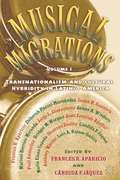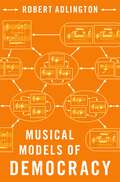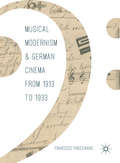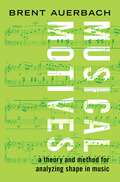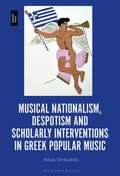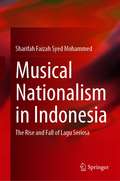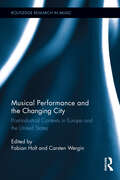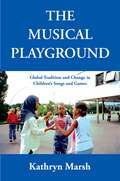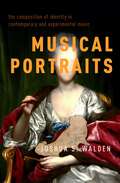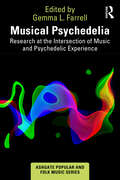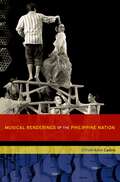- Table View
- List View
Musical Migrations: Transnationalism and Cultural Hybridity in Latin/o America, Volume I
by F. Aparicio C. JàquezA dynamic and original collection of essays on the transnational circulation and changing social meanings of Latin music across the Americas. The transcultural impact of Latin American musical forms in the United States calls for a deeper understanding of the shifting cultural meanings of music. Musical Migrations examines the tensions between the value of Latin popular music as a metaphor for national identity and its transnational meanings as it traverses national borders, geocultural spaces, audiences, and historical periods. The anthology analyzes, among others, the role of popular music in Caribbean diasporas in the United States and Europe, the trans-Caribbean identities of Salsa and reggae, the racial, cultural, and ethnic hybridity in rock across the Americas, and the tensions between tradition and modernity in Peruvian indigenous music, mariachi music in the United States, and in Trinidadian music.
Musical Minorities: The Sounds of Hmong Ethnicity in Northern Vietnam
by Lonán Ó BriainMusical Minorities is the first English-language monograph on the performing arts of an ethnic minority in Vietnam. Living primarily in the northern mountains, the Hmong have strategically maintained their cultural distance from foreign invaders and encroaching state agencies for almost two centuries. They use cultural heritage as a means of maintaining a resilient community identity, one which is malleable to their everyday needs and to negotiations among themselves and with others in the vicinity. Case studies of revolutionary songs, countercultural rock, traditional vocal and instrumental styles, tourist shows, animist and Christian rituals, and light pop from the diaspora illustrate the diversity of their creative outputs. This groundbreaking study reveals how performing arts shape understandings of ethnicity and nationality in contemporary Vietnam. Based on three years of fieldwork, Lonán Ó Briain traces the circulation of organized sounds that contribute to the adaptive capacities of this diverse social group. In an original investigation of the sonic materialization of social identity, the book outlines the full multiplicity of Hmong music-making through a fascinating account of music, minorities, and the state in a post-socialist context.
MUSICAL MINORITIES C: The Sounds of Hmong Ethnicity in Northern Vietnam
by Lonán Ó BriainMusical Minorities is the first English-language monograph on the performing arts of an ethnic minority in Vietnam. Living primarily in the northern mountains, the Hmong have strategically maintained their cultural distance from foreign invaders and encroaching state agencies for almost two centuries. They use cultural heritage as a means of maintaining a resilient community identity, one which is malleable to their everyday needs and to negotiations among themselves and with others in the vicinity. Case studies of revolutionary songs, countercultural rock, traditional vocal and instrumental styles, tourist shows, animist and Christian rituals, and light pop from the diaspora illustrate the diversity of their creative outputs. This groundbreaking study reveals how performing arts shape understandings of ethnicity and nationality in contemporary Vietnam. Based on three years of fieldwork, Lonán Ó Briain traces the circulation of organized sounds that contribute to the adaptive capacities of this diverse social group. In an original investigation of the sonic materialization of social identity, the book outlines the full multiplicity of Hmong music-making through a fascinating account of music, minorities, and the state in a post-socialist context.
Musical Models of Democracy
by Robert AdlingtonMusic's role in animating democracy--whether through protests and demonstrations, as a vehicle for political identity, or as a means of overcoming social divides--is well understood. Yet musicians have also been drawn to the potential of embodying democracy itself through musical processes and relationships. In this book, author Robert Adlington uses modern democratic theory to explore what he terms the 'musical modelling of democracy' as manifested in modern and experimental music of the global North. Throughout the book, Adlington demonstrates how composers and musicians have taken strikingly different approaches to this kind of musical modelling. For some, democratic principles inform the textural relationships inscribed into musical scores, as in the case of Elliott Carter's 'polyvocal' compositions. Pioneers of musical indeterminacy sought to democratise the relationship between composer and performers by leaving open key decisions about the realisation of a work. Musicians have involved audiences in active participation to liberate them from the passivity of spectatorship. Free improvisation groups have experimented with new kinds of egalitarian relationships between performers to reject old hierarchies. In examining these different approaches, Adlington illuminates the achievements and ambiguities of musical models of democracy. As a result, this book not only offers an important new perspective on modern musicians' engagement with a central political idea of the past century, but it also encourages a deeper and more critical engagement with the idea of democracy within present-day musical life.
Musical Models of Democracy
by Robert AdlingtonMusic's role in animating democracy--whether through protests and demonstrations, as a vehicle for political identity, or as a means of overcoming social divides--is well understood. Yet musicians have also been drawn to the potential of embodying democracy itself through musical processes and relationships. In this book, author Robert Adlington uses modern democratic theory to explore what he terms the 'musical modelling of democracy' as manifested in modern and experimental music of the global North. Throughout the book, Adlington demonstrates how composers and musicians have taken strikingly different approaches to this kind of musical modelling. For some, democratic principles inform the textural relationships inscribed into musical scores, as in the case of Elliott Carter's 'polyvocal' compositions. Pioneers of musical indeterminacy sought to democratise the relationship between composer and performers by leaving open key decisions about the realisation of a work. Musicians have involved audiences in active participation to liberate them from the passivity of spectatorship. Free improvisation groups have experimented with new kinds of egalitarian relationships between performers to reject old hierarchies. In examining these different approaches, Adlington illuminates the achievements and ambiguities of musical models of democracy. As a result, this book not only offers an important new perspective on modern musicians' engagement with a central political idea of the past century, but it also encourages a deeper and more critical engagement with the idea of democracy within present-day musical life.
Musical Modernism and German Cinema from 1913 to 1933
by Francesco FinocchiaroThis book investigates the relationship between musical Modernism and German cinema. It paves the way for anunorthodox path of research, one which has been little explored up until now. The main figures of musical Modernism, from Alban Berg to Paul Hindemith, and from Richard Strauss to Kurt Weill, actually had a significant relationship with cinema. True, it was a complex and contradictory relationship in which cinema often emerged more as an aesthetic point of reference than an objective reality; nonetheless, the reception of the language and aesthetic of cinema had significant influence on the domain of music. Between 1913 and 1933, Modernist composers’ exploration of cinema reached such a degree of pervasiveness and consistency as to become a true aesthetic paradigm, a paradigm that sat at the very heart of the Modernist project. In this insightful volume, Finocchiaro shows that the creative confrontation with the avant-garde medium par excellence can be regarded as a vector of musical Modernism: a new aesthetic paradigm for the very process – of deliberate misinterpretation, creative revisionism, and sometimes even intentional subversion of the Classic-Romantic tradition – which realized the “dream of Otherness” of the Modernist generation.
Musical Modernism and German Cinema from 1913 to 1933
by Francesco FinocchiaroThis book investigates the relationship between musical Modernism and German cinema. It paves the way for anunorthodox path of research, one which has been little explored up until now. The main figures of musical Modernism, from Alban Berg to Paul Hindemith, and from Richard Strauss to Kurt Weill, actually had a significant relationship with cinema. True, it was a complex and contradictory relationship in which cinema often emerged more as an aesthetic point of reference than an objective reality; nonetheless, the reception of the language and aesthetic of cinema had significant influence on the domain of music. Between 1913 and 1933, Modernist composers’ exploration of cinema reached such a degree of pervasiveness and consistency as to become a true aesthetic paradigm, a paradigm that sat at the very heart of the Modernist project. In this insightful volume, Finocchiaro shows that the creative confrontation with the avant-garde medium par excellence can be regarded as a vector of musical Modernism: a new aesthetic paradigm for the very process – of deliberate misinterpretation, creative revisionism, and sometimes even intentional subversion of the Classic-Romantic tradition – which realized the “dream of Otherness” of the Modernist generation.
Musical Motives: A Theory and Method for Analyzing Shape in Music
by Brent AuerbachAll music fans harbor in their memories vivid fragments of their favorite works. The starting guitar solo of "Satisfaction" by the Rolling Stones, the da-da-da-DUM gesture that opens Beethoven's Fifth Symphony, the lush swelling chords of a beloved movie soundtrack: hearing the briefest snippet of any of these is enough to transport listeners into the piece's sonic and emotional world. But what makes musical motives so powerful? In Musical Motives, author Brent Auerbach looks at the ways that motives the small-scale pitch and rhythm shapes that are ever-present in music unify musical compositions and shape our experiences of them. Motives serve both to communicate basic musical meaning and to tie together sound space like the motifs in visual art. They present in all genres from classical and popular to jazz and world music, making them ideally suited for analysis. Musical Motives opens with a general introduction to these fundamental building blocks, then lays out a comprehensive theory and method to account for music's structure and drama in motivic terms. Aimed at both amateur and expert audiences, the book offers a tiered approach that progresses from Basic to Complex Motivic Analysis. The methods are illustrated by small- and large-scale analyses of pieces by Mozart, Beethoven, Handel, Chaminade, Verdi, Radiohead, and many more.
Musical Motives: A Theory and Method for Analyzing Shape in Music
by Brent AuerbachAll music fans harbor in their memories vivid fragments of their favorite works. The starting guitar solo of "Satisfaction" by the Rolling Stones, the da-da-da-DUM gesture that opens Beethoven's Fifth Symphony, the lush swelling chords of a beloved movie soundtrack: hearing the briefest snippet of any of these is enough to transport listeners into the piece's sonic and emotional world. But what makes musical motives so powerful? In Musical Motives, author Brent Auerbach looks at the ways that motives the small-scale pitch and rhythm shapes that are ever-present in music unify musical compositions and shape our experiences of them. Motives serve both to communicate basic musical meaning and to tie together sound space like the motifs in visual art. They present in all genres from classical and popular to jazz and world music, making them ideally suited for analysis. Musical Motives opens with a general introduction to these fundamental building blocks, then lays out a comprehensive theory and method to account for music's structure and drama in motivic terms. Aimed at both amateur and expert audiences, the book offers a tiered approach that progresses from Basic to Complex Motivic Analysis. The methods are illustrated by small- and large-scale analyses of pieces by Mozart, Beethoven, Handel, Chaminade, Verdi, Radiohead, and many more.
Musical Nationalism, Despotism and Scholarly Interventions in Greek Popular Music
by Nikos OrdoulidisThis book discusses the relationship between Greek Orthodox ecclesiastical music and laiko (popular) song in Greece. Laiko music was long considered a lesser form of music in Greece, with rural folk music considered serious enough to carry the weight of the ideologies founded within the establishment of the contemporary Greek state. During the 1940s and 1950s, a selective exoneration of urban popular music took place, one of its most popular cases being the originating relationships between two extremely popular musical pieces: Vasilis Tsitsanis's “Synnefiasmeni Kyriaki” (Cloudy Sunday) and its descent from the hymn “Ti Ypermacho” (The Akathist Hymn). During this period the connection of these two pieces was forged in the Modern Greek conscience, led by certain key figures in the authority system of the scholarly world. Through analysis of these pieces and the surrounding contexts, Ordoulidis explores the changing role and perception of popular music in Greece.
Musical Nationalism, Despotism and Scholarly Interventions in Greek Popular Music
by Nikos OrdoulidisThis book discusses the relationship between Greek Orthodox ecclesiastical music and laiko (popular) song in Greece. Laiko music was long considered a lesser form of music in Greece, with rural folk music considered serious enough to carry the weight of the ideologies founded within the establishment of the contemporary Greek state. During the 1940s and 1950s, a selective exoneration of urban popular music took place, one of its most popular cases being the originating relationships between two extremely popular musical pieces: Vasilis Tsitsanis's “Synnefiasmeni Kyriaki” (Cloudy Sunday) and its descent from the hymn “Ti Ypermacho” (The Akathist Hymn). During this period the connection of these two pieces was forged in the Modern Greek conscience, led by certain key figures in the authority system of the scholarly world. Through analysis of these pieces and the surrounding contexts, Ordoulidis explores the changing role and perception of popular music in Greece.
Musical Nationalism in Indonesia: The Rise and Fall of Lagu Seriosa
by Sharifah Faizah MohammedThis book charts the growth of the Indonesian nationalistic musical genre of lagu seriosa in relation to the archipelago's history in the 1950s and 1960s, examining how folk songs were implemented as a valuable tool for promoting government propaganda. The author reveals how the genre was shaped to fit state ideologies and agendas in the Sukarno and Soeharto eras. It also reveals the very significant role played by Radio Republik Indonesia in the genre’s development and dissemination. Little research has been done to investigate how Indonesian music contributed to nation-building during Indonesia’s immediate post-colonial period. Emulating the European art song, the genre was adapted to compose songs with the purpose of promoting a strengthened collective Indonesian identity, fostered by a group of musicians who functioned as gatekeepers, monitoring and devising various mechanisms for songs to conform to the propagandistic needs of the Indonesian government at the time. The result was the development of classical style of singing and the cultivation of a patriotic collection of music during the Guided Democracy period (1959–1965), which peaked at the height of the Konfrontasi (1963–1966). Lagu seriosa lost popularity as popular music infiltrated Indonesia in the 1970s, but it remains an iconic yet understudied aspect of the nationalistic agenda in Indonesia. The case studies of selected songs reflected continuity and change in musical style and over time. This book is of interest to scholars studying the intersection between history, politics, identity, arts and cultural studies in Indonesia. It is also of interest to researchers investigating the role of music in identity formation and nation-building more widely.
Musical Pathways in Recovery: Community Music Therapy and Mental Wellbeing (Music and Change: Ecological Perspectives)
by Gary Ansdell Tia DeNora"Music triggered a healing process from within me. I started singing for the joy of singing myself and it helped me carry my recovery beyond the state I was in before I fell ill nine years ago to a level of well-being that I haven't had perhaps for thirty years." This book explores the experiences of people who took part in a vibrant musical community for people experiencing mental health difficulties, SMART (St Mary Abbotts Rehabilitation and Training). Ansdell (a music therapist/researcher) and DeNora (a music sociologist) describe their long-term ethnographic work with this group, charting the creation and development of a unique music project that won the 2008 Royal Society for Public Health Arts and Health Award. Ansdell and DeNora track the 'musical pathways' of a series of key people within SMART, focusing on changes in health and social status over time in relation to their musical activity. The book includes the voices and perspectives of project members and develops with them a new understanding of how music promotes their health and wellbeing. A contemporary ecological understanding of 'music and change' is outlined, drawing on and further developing theory from music sociology and Community Music Therapy. This innovative book will be of interest to anyone working in the mental health field, but also music therapists, sociologists, musicologists, music educators and ethnomusicologists. This volume completes a three part 'triptych', alongside the other volumes, Music Asylums: Wellbeing Through Music in Everyday Life, and How Music Helps: In Music Therapy and Everyday Life.
Musical Pathways in Recovery: Community Music Therapy and Mental Wellbeing (Music and Change: Ecological Perspectives)
by Gary Ansdell Tia DeNora"Music triggered a healing process from within me. I started singing for the joy of singing myself and it helped me carry my recovery beyond the state I was in before I fell ill nine years ago to a level of well-being that I haven't had perhaps for thirty years." This book explores the experiences of people who took part in a vibrant musical community for people experiencing mental health difficulties, SMART (St Mary Abbotts Rehabilitation and Training). Ansdell (a music therapist/researcher) and DeNora (a music sociologist) describe their long-term ethnographic work with this group, charting the creation and development of a unique music project that won the 2008 Royal Society for Public Health Arts and Health Award. Ansdell and DeNora track the 'musical pathways' of a series of key people within SMART, focusing on changes in health and social status over time in relation to their musical activity. The book includes the voices and perspectives of project members and develops with them a new understanding of how music promotes their health and wellbeing. A contemporary ecological understanding of 'music and change' is outlined, drawing on and further developing theory from music sociology and Community Music Therapy. This innovative book will be of interest to anyone working in the mental health field, but also music therapists, sociologists, musicologists, music educators and ethnomusicologists. This volume completes a three part 'triptych', alongside the other volumes, Music Asylums: Wellbeing Through Music in Everyday Life, and How Music Helps: In Music Therapy and Everyday Life.
Musical Performance And The Changing City: Post-industrial Contexts In Europe And The United States (Routledge Research In Music Ser.)
by Fabian Holt Carsten WerginA contribution to the field of urban music studies, this book presents new interdisciplinary approaches to the study of music in urban social life. It takes musical performance as its key focus, exploring how and why different kinds of performance are evolving in contemporary cities in the interaction among social groups, commercial entrepreneurs, and institutions. From conventional concerts in rock clubs to new genres such as the flash mob, the forms and meanings of musical performance are deeply affected by urban social change and at the same time respond to the changing conditions. Music has taken on complex roles in the post-industrial city where culture and cultural consumption have an unprecedented power in defining publics, policies, and marketing strategies. Further, changes in real estate markets and the penetration of new media have challenged even fairly modern music cultures. At the same time, new music cultures have emerged, and music has become a driver for cultural events and festivals, channeling the dynamics of a society characterized by the social change, media intensity, and the neoliberal forces of post-industrial urban contexts. The volume brings together scholars from a broad range of disciplines to build a shared understanding of post-industrial contexts in Europe and the United States. Most directly grounded in contemporary developments in music studies and urban studies, its broad interdisciplinary range serves to strengthen the relevance of urban music studies to fields such as anthropology, sociology, urban geography, and beyond. Offering in-depth studies of changing music culture in concert venues, cultural events, and neighborhoods, contributors visit diverse locations such as Barcelona, Berlin, London, New York, and Austin.
Musical Performance And The Changing City: Post-industrial Contexts In Europe And The United States (Routledge Research In Music Ser.)
by Fabian Holt Carsten WerginA contribution to the field of urban music studies, this book presents new interdisciplinary approaches to the study of music in urban social life. It takes musical performance as its key focus, exploring how and why different kinds of performance are evolving in contemporary cities in the interaction among social groups, commercial entrepreneurs, and institutions. From conventional concerts in rock clubs to new genres such as the flash mob, the forms and meanings of musical performance are deeply affected by urban social change and at the same time respond to the changing conditions. Music has taken on complex roles in the post-industrial city where culture and cultural consumption have an unprecedented power in defining publics, policies, and marketing strategies. Further, changes in real estate markets and the penetration of new media have challenged even fairly modern music cultures. At the same time, new music cultures have emerged, and music has become a driver for cultural events and festivals, channeling the dynamics of a society characterized by the social change, media intensity, and the neoliberal forces of post-industrial urban contexts. The volume brings together scholars from a broad range of disciplines to build a shared understanding of post-industrial contexts in Europe and the United States. Most directly grounded in contemporary developments in music studies and urban studies, its broad interdisciplinary range serves to strengthen the relevance of urban music studies to fields such as anthropology, sociology, urban geography, and beyond. Offering in-depth studies of changing music culture in concert venues, cultural events, and neighborhoods, contributors visit diverse locations such as Barcelona, Berlin, London, New York, and Austin.
The Musical Playground: Global Tradition and Change in Children's Songs and Games
by Kathryn MarshThe Musical Playground is a new and fascinating account of the musical play of school-aged children. Based on fifteen years of ethnomusicological field research in urban and rural school playgrounds around the globe, Kathryn Marsh provides unique insights into children's musical playground activities across a comprehensive scope of social, cultural, and national contexts. With a sophisticated synthesis of ethnomusicological and music education approaches, Marsh examines sung and chanted games, singing and dance routines associated with popular music and sports chants, and more improvised and spontaneous chants, taunts, and rhythmic movements. The book's index of more than 300 game genres is a valuable reference to readers in the field of children's folklore, providing a unique map of game distribution across an array of cultures and geographical locations. On the companion website, readers will be able to view on streamed video, field recordings of children's musical play throughout the wide range of locations and cultures that form the core of Marsh's study, allowing them to better understand the music, movement, and textual characteristics of musical games and interactions. Copious notated musical examples throughout the book and the website demonstrate characteristics of game genres, children's generative practices, and reflections of cultural influences on game practice, and valuable, practical recommendations are made for developing pedagogies which reflect more child-centred and less Eurocentric views of children's play, musical learning, and musical creativity. Marsh brings readers to playgrounds in Australia, Norway, the USA, the United Kingdom, and Korea, offering them an important and innovative study of how children transmit, maintain, and transform the games of the playground. The Musical Playground will appeal to practitioners and researchers in music education, ethnomusicology, and folklore.
The Musical Playground: Global Tradition and Change in Children's Songs and Games
by Kathryn MarshThe Musical Playground is a new and fascinating account of the musical play of school-aged children. Based on fifteen years of ethnomusicological field research in urban and rural school playgrounds around the globe, Kathryn Marsh provides unique insights into children's musical playground activities across a comprehensive scope of social, cultural, and national contexts. With a sophisticated synthesis of ethnomusicological and music education approaches, Marsh examines sung and chanted games, singing and dance routines associated with popular music and sports chants, and more improvised and spontaneous chants, taunts, and rhythmic movements. The book's index of more than 300 game genres is a valuable reference to readers in the field of children's folklore, providing a unique map of game distribution across an array of cultures and geographical locations. On the companion website, readers will be able to view on streamed video, field recordings of children's musical play throughout the wide range of locations and cultures that form the core of Marsh's study, allowing them to better understand the music, movement, and textual characteristics of musical games and interactions. Copious notated musical examples throughout the book and the website demonstrate characteristics of game genres, children's generative practices, and reflections of cultural influences on game practice, and valuable, practical recommendations are made for developing pedagogies which reflect more child-centred and less Eurocentric views of children's play, musical learning, and musical creativity. Marsh brings readers to playgrounds in Australia, Norway, the USA, the United Kingdom, and Korea, offering them an important and innovative study of how children transmit, maintain, and transform the games of the playground. The Musical Playground will appeal to practitioners and researchers in music education, ethnomusicology, and folklore.
Musical Portraits: The Composition of Identity in Contemporary and Experimental Music
by Joshua S. WaldenJoshua S. Walden's Musical Portraits: The Composition of Identity in Contemporary and Experimental Music explores the wide-ranging but under-examined genre of musical portraiture. It focuses in particular on contemporary and experimental music created between 1945 and the present day, an era in which conceptions of identity have changed alongside increasing innovation in musical composition as well as in the uses of abstraction, mixed media, and other novel techniques in the field of visual portraiture. In the absence of physical likeness, an element typical of portraiture that cannot be depicted in sound, composers have experimented with methods of constructing other attributes of identity in music, such as character, biography, and profession. By studying musical portraits of painters, authors, and modern celebrities, in addition to composers' self-portraits, the book considers how representational and interpretive processes overlap and differ between music and other art forms, as well as how music is used in the depiction of human identities. Examining a range of musical portraits by composers including Peter Ablinger, Pierre Boulez, Morton Feldman, Philip Glass, György Ligeti, and Virgil Thomson, and director Robert Wilson's on-going series of video portraits of modern-day celebrities and his "portrait opera" Einstein on the Beach, Musical Portraits contributes to the study of music since 1945 through a detailed examination of contemporary understandings of music's capacity to depict identity, and of the intersections between music, literature, theater, film, and the visual arts.
Musical Portraits: The Composition of Identity in Contemporary and Experimental Music
by Joshua S. WaldenJoshua S. Walden's Musical Portraits: The Composition of Identity in Contemporary and Experimental Music explores the wide-ranging but under-examined genre of musical portraiture. It focuses in particular on contemporary and experimental music created between 1945 and the present day, an era in which conceptions of identity have changed alongside increasing innovation in musical composition as well as in the uses of abstraction, mixed media, and other novel techniques in the field of visual portraiture. In the absence of physical likeness, an element typical of portraiture that cannot be depicted in sound, composers have experimented with methods of constructing other attributes of identity in music, such as character, biography, and profession. By studying musical portraits of painters, authors, and modern celebrities, in addition to composers' self-portraits, the book considers how representational and interpretive processes overlap and differ between music and other art forms, as well as how music is used in the depiction of human identities. Examining a range of musical portraits by composers including Peter Ablinger, Pierre Boulez, Morton Feldman, Philip Glass, György Ligeti, and Virgil Thomson, and director Robert Wilson's on-going series of video portraits of modern-day celebrities and his "portrait opera" Einstein on the Beach, Musical Portraits contributes to the study of music since 1945 through a detailed examination of contemporary understandings of music's capacity to depict identity, and of the intersections between music, literature, theater, film, and the visual arts.
Musical Practice as a Form of Life: How Making Music Can be Meaningful and Real (Musik und Klangkultur #32)
by Eva-Maria HoubenHow is musical practice connected with everyday life? Eva-Maria Houben shows that performing music as an activity - indeed, as playing - is a meaningful shift from an approach based on structural analysis. Musical practice, Eva-Maria Houben contends, can be understood as open and never finished. Such an emphasis on repetition offers freedom from perfection, productivity, and purpose, thus allowing meaning to unfold in specific situations, places, and relationships. Musical practice can become a form of life and a reality in its own right. The study includes musical examples from the 17th, 18th, 19th, and 20th centuries as well as contemporary music.
Musical Psychedelia: Research at the Intersection of Music and Psychedelic Experience (Ashgate Popular and Folk Music Series)
by Gemma L. FarrellPsychedelic music is a fascinating yet under-researched field of study. This thought-provoking collection offers a broad introduction to the fi eld of psychedelic music studies, bringing together scholarly work on psychedelic music in genres like rock, folk, electronic dance music and pop. Through an expanded purview on psychedelic music, an emerging trend in research, the collection affords students and academics alike an introduction to a rich, multi-faceted field. The contributing authors explore a range of different facets of musical psychedelia: its transgressive and transcendent aspects, its foregrounding of timbre and texture, the way it changes our perception of time, its influence on “non-psychedelic” music, key composition and production techniques that composers and musicians use in its creation, how it is mediated by different places and spaces, and the interplay between psychedelic visual and sonic aesthetics. This interdisciplinary work reveals both commonalities in musical psychedelic experiences and the contestation inherent in a fi eld of study that juxtaposes music of different genres and eras with a variety of theoretical approaches and methodologies. In broadening the scope of psychedelic music research, the collection not only makes for varied and absorbing reading on the subject level but also stimulates reflexive thought about interdisciplinary research.
Musical Psychedelia: Research at the Intersection of Music and Psychedelic Experience (Ashgate Popular and Folk Music Series)
Psychedelic music is a fascinating yet under-researched field of study. This thought-provoking collection offers a broad introduction to the fi eld of psychedelic music studies, bringing together scholarly work on psychedelic music in genres like rock, folk, electronic dance music and pop. Through an expanded purview on psychedelic music, an emerging trend in research, the collection affords students and academics alike an introduction to a rich, multi-faceted field. The contributing authors explore a range of different facets of musical psychedelia: its transgressive and transcendent aspects, its foregrounding of timbre and texture, the way it changes our perception of time, its influence on “non-psychedelic” music, key composition and production techniques that composers and musicians use in its creation, how it is mediated by different places and spaces, and the interplay between psychedelic visual and sonic aesthetics. This interdisciplinary work reveals both commonalities in musical psychedelic experiences and the contestation inherent in a fi eld of study that juxtaposes music of different genres and eras with a variety of theoretical approaches and methodologies. In broadening the scope of psychedelic music research, the collection not only makes for varied and absorbing reading on the subject level but also stimulates reflexive thought about interdisciplinary research.
Musical Renderings of the Philippine Nation (New Cultural History of Music)
by Christi-Anne CastroThe first cultural history of the Philippines during the twentieth century, Musical Renderings of the Philippine Nation focuses on the relationships between music, performance, and ideologies of nation. Spanning the hundred years from the Filipino-American War to the 1998 Centennial celebration of the nation's independence from Spain, the book has added emphasis on the period after World War II. Author Christi-Anne Castro describes the narratives of nation embedded in several major musical genres, such as classical music and folkloric song and dance, and enacted by the most well-known performers of the country, including Bayanihan, The Philippine National Dance Company and the Philippine Madrigal Singers. Castro delves into the ideas and works of prominent native composers, from the popular art music of Francisco Santiago and Lucio San Pedro to the People Power anthem of 1986 by Jim Paredes of the group Apo Hiking Society. Through both archival research and ethnographic fieldwork, Castro reveals how individuals and groups negotiate with and contest the power of the state to define the nation as a modern and hybrid entity within a global community.
Musical Resilience: Performing Patronage in the Indian Thar Desert (Music / Culture)
by Shalini R. AyyagariIn Musical Resilience, Shalini Ayyagari shows how professional low-caste musicians from the Thar Desert borderland of Rajasthan, India have skillfully reinvented their cultural and economic value in postcolonial India. Before India's independence in 1947, the Manganiyar community of hereditary musicians were tied to traditional patrons over centuries and through hereditary ties. In postcolonial India, traditional patronage relations faded due to new political conditions, technological shifts, and cultural change. Ayyagari uses resilience, one of the most poignant keywords of our times, to understand how Manganiyar musicians sustain and enliven their cultural significance after the fading of traditional patronage.
